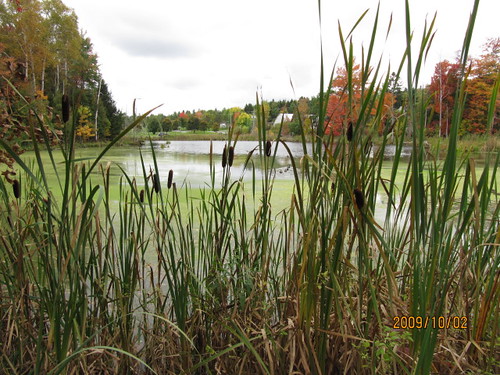
This is at the start of Spooner Island, which is on the left.
Typha is a genus of about eleven species of monocotyledonous flowering plants in the monogeneric family, Typhaceae. The genus has a largely Northern Hemisphere distribution, but is essentially cosmopolitan, being found in a variety of wetland habitats. These plants are known in British English as bulrush, bullrush or reedmace, and in American English as cattail, punks, or corndog grass. Typha should not be confused with other plants known as bulrush, such as those of the genus Scirpus.
Cattails are alternate and mostly basal to a simple, jointless stem that eventually bears the flowers. The rhizomes spread horizontally beneath the surface of muddy ground to start new upright growth, and the spread of cattails is an important part of the process of open water bodies being converted to vegetated marshland and eventually dry land.
Typha plants are monoecious, wind-pollinated, and bear unisexual flowers developing in dense, complex spikes. The male flower spike develops at the top of the vertical stem, above the female flower spike. The male (staminate) flowers are reduced to a pair of stamens and hairs and wither once the pollen is shed, leaving a short, bare stem portion above the female inflorescence. The dense cluster of female flowers forms a cylindrical spike some 10 to as much as 40 cm long and 1 to 4 cm broad. Seeds are minute (about 0.2 mm long), and attached to a thin hair or stalk, which effects wind dispersal. Typha are often among the first wetland plants to colonize areas of newly exposed wet mud.
Species
Typha angustifolia - Lesser Bulrush or Narrow Leaf Cattail
Typha domingensis - Southern Cattail
Typha ×glauca (angustifolia × latifolia) - Hybrid or White Cattail
Typha latifolia - Common Cattail
Typha laxmannii - Laxman's Bulrush
Typha minima - Dwarf Bulrush
Typha muelleri - Raupo
Typha orientalis - Raupo
Typha shuttleworthii - Shuttleworth's Bulrush
Typha plants at the edge of a small wetland in Indiana.The most widespread species is Typha latifolia, extending across the entire temperate northern hemisphere. T. angustifolia is nearly as widespread, but does not extend so far north; it is introduced and invasive in North America. T. domingensis is a more southerly American species, extending from the U.S. to South America, while T. laxmannii, T. minima and T. shuttleworthii are largely restricted to Asia and parts of southern Europe.
Typha latifoliaTypha plants grow along lake margins and in marshes, often in dense colonies, and are sometimes considered a weed in managed wetlands. The plant's root systems help prevent erosion, and the plants themselves are often home to many insects, birds and amphibians.
In North America, the native cattails are increasingly being supplanted by the invasive Typha angustifolia, Typha ×glauca and purple loosestrife Lythrum salicaria.
Edible uses
Cattails have a wide variety of parts that are edible to humans. The rhizomes are a pleasant, nutritious and energy-rich food source, generally harvested from late Autumn to early Spring. These are starchy, but also fibrous, so the starch must be scraped or sucked from the tough fibers. In addition to the rhizomes, cattails have little-known, underground, lateral stems that are quite tasty. In late spring, the bases of the leaves, while they are young and tender, can be eaten raw or cooked. As the flower spike is developing in early summer, it can be broken off and eaten like corn on the cob. In mid-summer, once the male flowers are mature, the pollen can be collected and used as a flour supplement or thickener. Cattails have also recently been suggested as a source of oil.
The boiled rootstocks have been used for increasing urination, or used mashing, to make a jelly-like paste for sores, boils, wounds, burns, scabs, inflammations, and smallpox pustules.
Other uses
Typha seeds are very small, embedded in down parachutes, and very effectively wind-dispersedThe disintegrating heads are used by some birds to line their nests. The downy material was also used by Native Americans as tinder for starting fires.
Native American tribes also used cattail down to line moccasins, provide bedding, diapers, baby powder, and papoose boards. An Indian name for cattail meant, “fruit for papoose’s bed”. Today some people still use cattail down to stuff clothing items and pillows.
The down has also been used to fill life vests in the same manner as kapok.
If using the cattail for pillow stuffing, it is suggested to use thick batting material, as the fluff may cause a skin reaction similar to urticaria.
Cattails can be used as a source of ethanol, instead of cereals. They have the advantage that they do not require much, if any, maintenance.
One informal experiment has shown that cattails are able to remove arsenic, which is dangerous when consumed by humans, from drinking water. Such a filtration system may be one way to provide cheap water filtration to people in developing nations.

1 comment:
Lots of wonderful reading here, many thanks! I had been browsing on yahoo when I identified your article, I’m going to add your feed to Google Reader, I look forward to more from you.
Post a Comment